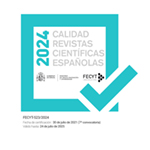La guadúa que se corta: paisajes culturales y patrimonio construido en la costa ecuatoriana (Manabí, Ecuador)
Resumen
El bambú y la madera generaron una arquitectura nueva durante el primer periodo de expansión cacaotera (siglos XVIII-XIX) en Ecuador, marcada por influencias europeas. El estudio de las construcciones se ha realizado tradicionalmente en términos monumentalistas. Gran parte de ellas se encuentran en peligro de desaparición como resultado de las reducidas políticas locales de conservación, la escasez de normativas de protección, y una pérdida de las tradiciones en torno a la explotación del bambú. La investigación plantea un estudio multidisciplinar en el área sur de la provincia de Manabí, con un primer acercamiento etnográfico. Se analizan las posibilidades de desarrollo en torno a la protección del espacio urbano más emblemático de la arquitectura en guadúa, la ciudad de Jipijapa. Al mismo tiempo, se examina la construcción de nuevos paradigmas «culturales» en la región costera del Ecuador como resultado de la reformulación del Estado ecuatoriano. La nueva realidad surgida sitúa en un segundo plano los tradicionales «patrimonios culturales dominantes», siendo uno de los más representativos la arquitectura del periodo cacaotero.Descargas
Descarga artículo
Licencia
La Revista Española de Antropología Americana, para fomentar el intercambio global del conocimiento, facilita el acceso sin restricciones a sus contenidos desde el momento de su publicación en la presente edición electrónica, y por eso es una revista de acceso abierto. Los originales publicados en esta revista son propiedad de la Universidad Complutense de Madrid y es obligatorio citar su procedencia en cualquier reproducción total o parcial. Todos los contenidos se distribuyen bajo una licencia de uso y distribución Creative Commons Reconocimiento 4.0 (CC BY 4.0). Esta circunstancia ha de hacerse constar expresamente de esta forma cuando sea necesario. Puede consultar la versión informativa y el texto legal de la licencia.









